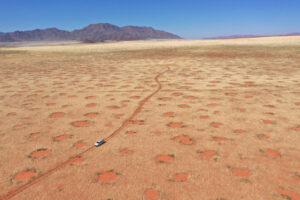Researchers led by Göttingen University show that plant water stress not termites causes mysterious circles
Scientists have puzzled over the origin of Namibia’s fairy circles for nearly half a century. It boiled down to two main theories: either termites were responsible, or plants were somehow self-organizing. Now, researchers from the University of Göttingen, benefitting from two exceptionally good rainfall seasons in the Namib Desert, show that the grasses within the fairy circles died immediately after rainfall, but termite activity did not cause the bare patches. Instead, continuous soil-moisture measurements demonstrate that the grasses around the circles strongly depleted the water within the circles and thereby likely induced the death of the grasses inside the circles. The results were published in Perspectives in Plant Ecology, Evolution and Systematics.
About 80-140 kilometres from the coast in the Namib, there are millions of fairy circles – circular gaps in the grassland, each a few meters wide, together forming a distinctive pattern across the whole landscape and visible for miles around. The researchers followed the sporadic rain events in several regions in this desert and examined the grasses, their roots and shoots, and potential root damage induced by termites. Termites, tiny insects that live in large colonies around the world, have often been blamed for the death of the grasses. The researchers took great care to investigate the circumstances of dying grasses within fairy circles right from straight after the rainfall, which triggered the new growth of the grasses. Additionally, they installed soil-moisture sensors in and around the fairy circles to record the soil-water content at 30-minute intervals starting in the dry season 2020 to the end of the rainy season 2022. This enabled the researchers to record precisely how the growth of the new emerging grasses around the circles affected the soil water within and around the circles. They investigated the differences in water infiltration between the inside and outside of circles at ten regions across the Namib.

The data show that about ten days after rainfall, the grasses were already starting to die within the circles while most of the interior area of the circles did not have grass germination at all. Twenty days after rainfall, the struggling grasses within the circles were completely dead and yellowish in colour while the surrounding grasses were vital and green. When the researchers examined the roots of the grasses from within the circles and compared them to the green grasses on the outside, they found that the roots within the circles were as long as, or even longer than, those outside. This indicated that the grasses were putting effort into the growth of roots in search of water. However, the researchers found no evidence for termites feeding on roots. It was not until fifty to sixty days after the rainfall that root damage became more visible at the dead grasses. Dr Stephan Getzin, Department of Ecosystem Modelling at the University of Göttingen, explains: “The sudden absence of grass for most areas within the circles cannot be explained by the activity of termites because there was no biomass for these insects to feed on. But more importantly, we can show that the termites are not responsible because the grasses die immediately after rainfall without any sign of creatures feeding on the root.”
When the researchers analyzed the data on soil-moisture fluctuations, they found that the decline in soil water inside and outside of the circles was very slow after initial rainfall, when grasses were not yet established. However, when the surrounding grasses were well established, the decline in soil water after rainfall was very fast in all areas, even though there were almost no grasses within the circles to take the water. Getzin explains: “Under the strong heat in the Namib, the grasses are permanently transpiring and losing water. Hence, they create soil-moisture vacuums around their roots and water is drawn towards them. Our results strongly agree with those of researchers who have shown that water in soil diffuses quickly and horizontally in these sands even over distances greater than seven meters.”
Getzin adds: “By forming strongly patterned landscapes of evenly spaced fairy circles, the grasses act as ecosystem engineers and benefit directly from the water resource provided by the vegetation gaps. In fact, we know related self-organized vegetation structures from various other harsh drylands in the world, and in all those cases the plants have no other chance to survive except by growing exactly in such geometrical formations.” This research has implications for understanding similar ecosystems, especially with regard to climate change, because the self-organization of plants buffers against negative effects induced by increasing aridification.
This research was funded by the German Research Foundation (DFG).
Read the paper: Perspectives in Plant Ecology, Evolution and Systematics
Article source: University of Göttingen
Image credit: Co-author, Sönke Holch, downloading data from a data logger in the Namib in February 2021 when the grasses reached their peak biomass. Credit: Dr Stephan Getzin








